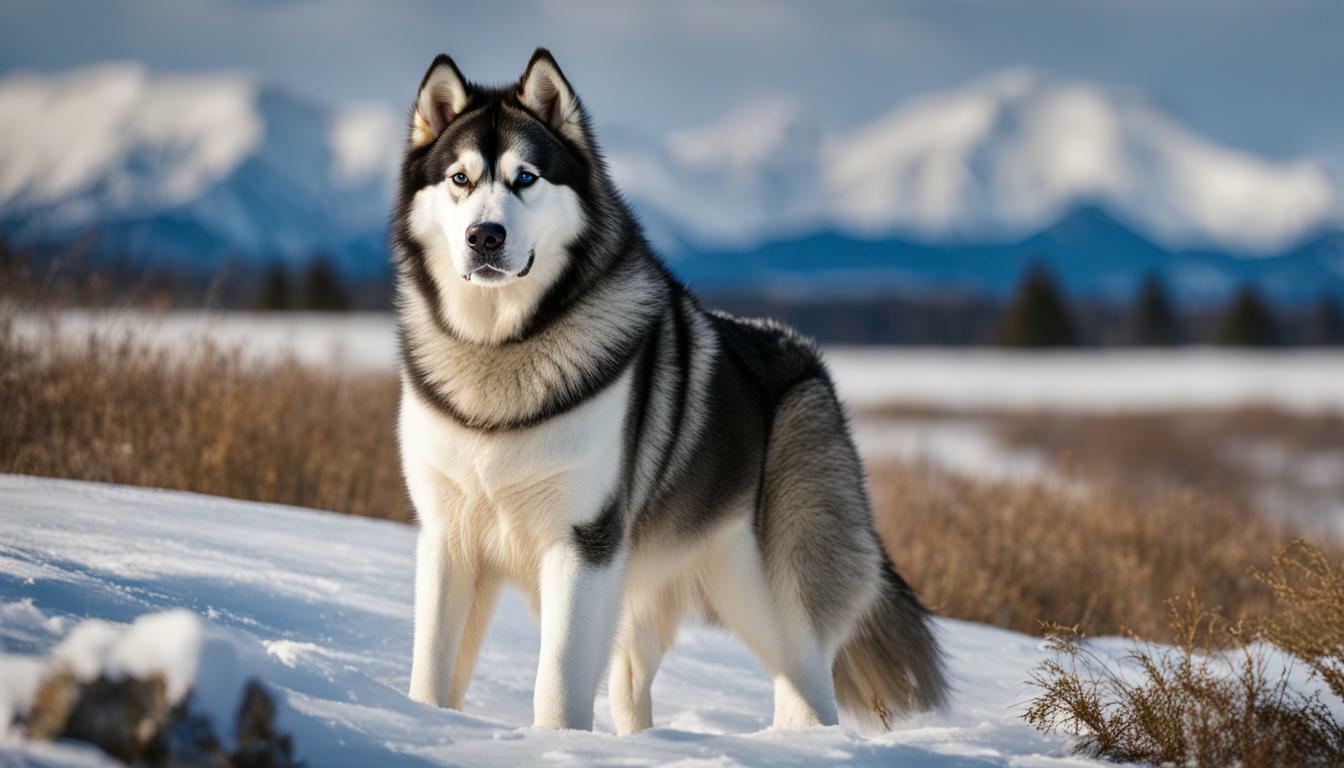Alaskan Malamutes are renowned for their striking appearance, but do they possess the captivating blue eyes that are often associated with certain dog breeds?
No, purebred Alaskan Malamutes do not have blue eyes. The official breed standard states that their eyes should be brown. Blue eyes on Malamutes can be the result of crossbreeding with Siberian Huskies or a gene that causes white spotting. Blue eyes are considered a disqualifying fault in Alaskan Malamutes according to the breed standard. If a Malamute has blue eyes, it is likely a result of crossbreeding or the presence of the white spotting gene. Although very rare, there have been a few documented cases of purebred Malamutes with blue eyes. Malamute puppies are born with blue eyes, but their eye color will change as they grow older. Other dog breeds that commonly have blue eyes include Siberian Huskies, Australian Shepherds, Border Collies, and Great Danes.
The Official Breed Standard for Alaskan Malamutes Eye Color
The eye color of Alaskan Malamutes is subject to specific standards set forth by breed organizations, which outline the expected characteristics and variations. According to the official breed standard, the eyes of purebred Alaskan Malamutes should be brown. This consistent eye color is an important feature of the breed’s overall appearance.
Alaskan Malamute eye color is primarily determined by genetics. Different genes influence the pigmentation of the iris, resulting in variations such as shades of brown. While brown is the standard and most common eye color for Alaskan Malamutes, variations within this color range are acceptable as long as they conform to the breed standard.
It’s worth noting that blue eyes in Alaskan Malamutes are considered a disqualifying fault. However, blue eyes can occasionally occur in the breed due to crossbreeding with Siberian Huskies or the presence of the white spotting gene. These occurrences are rare and not in line with the official breed standard.
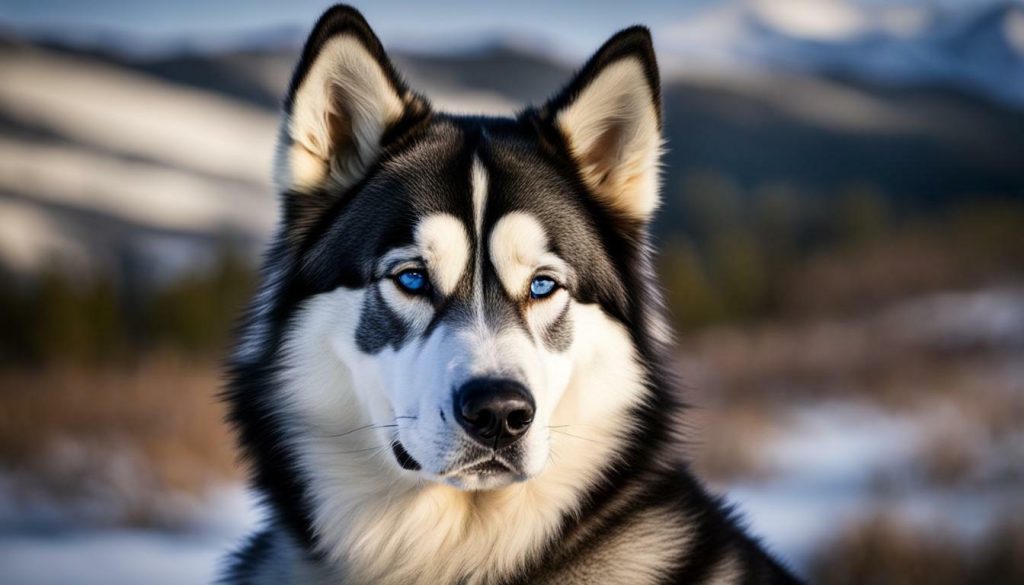
It is important for breeders and enthusiasts to adhere to the established breed standard to preserve the desired characteristics and maintain the integrity of the Alaskan Malamute breed. The breed organizations emphasize the importance of breeding for proper eye color and discourage the breeding of blue-eyed individuals.
| Eye Color | Description |
|---|---|
| Brown | The desired and standard eye color for Alaskan Malamutes. Different shades of brown are acceptable within this range. |
| Blue | Considered a disqualifying fault according to the breed standard. Blue eyes can occur due to crossbreeding or the presence of the white spotting gene. |
| Other Variations | While less common, other variations within the brown color range may be present in Alaskan Malamutes, as long as they adhere to the breed standard. |
Overall, the official breed standard for Alaskan Malamute eye color emphasizes the importance of brown eyes while acknowledging the potential variations within this range. Breeders and enthusiasts should ensure that their Alaskan Malamutes meet these standards to maintain the unique and distinctive appearance of the breed.
Blue Eyes in Alaskan Malamutes: Causes and Implications
Although blue eyes are not the norm for purebred Alaskan Malamutes, there are instances where this eye color variation may occur due to specific genetic factors or crossbreeding. The official breed standard states that Alaskan Malamutes should have brown eyes, making blue eyes a disqualifying fault according to the standard. However, it is important to understand the causes and implications of blue eyes in these majestic dogs.
One of the main reasons for blue eyes in Alaskan Malamutes is crossbreeding with Siberian Huskies, a breed known for their blue eyes. When Malamutes are bred with Huskies, there is a higher chance of blue-eyed offspring. Additionally, the presence of the white spotting gene, which can cause patches of white fur, can also lead to blue eyes in Malamutes.
It is crucial to note that blue eyes in Alaskan Malamutes are relatively rare. While there have been a few documented cases of purebred Malamutes with blue eyes, they are exceptions rather than the norm. The breed standard emphasizes the importance of adhering to the desired eye color, which is brown, in order to maintain the integrity of the breed.
| Blue Eyes in Alaskan Malamutes: | Causes and Implications |
|---|---|
| Causes | Crossbreeding with Siberian Huskies |
| Presence of the white spotting gene | |
| Implications | Considered a disqualifying fault |
As Alaskan Malamute puppies grow, their eye color can undergo changes. Like many other dog breeds, Malamute puppies are born with blue eyes and gradually develop their adult eye color. This transition typically occurs within the first few months of the puppy’s life. So, even if a Malamute puppy initially has blue eyes, there is a high probability that the eye color will change as it matures.
When discussing blue eyes in Alaskan Malamutes, it is also interesting to compare them with other dog breeds that commonly have blue eyes. Breeds like Siberian Huskies, Australian Shepherds, Border Collies, and Great Danes are known for their blue-eyed individuals. However, each breed has unique genetic factors that contribute to their eye color variations.
Blue-eyed Dog Breeds:
“Blue eyes are more common in certain dog breeds due to specific genetic factors. While they may be a striking feature, it is important to remember that eye color alone does not define a dog’s beauty or personality.”
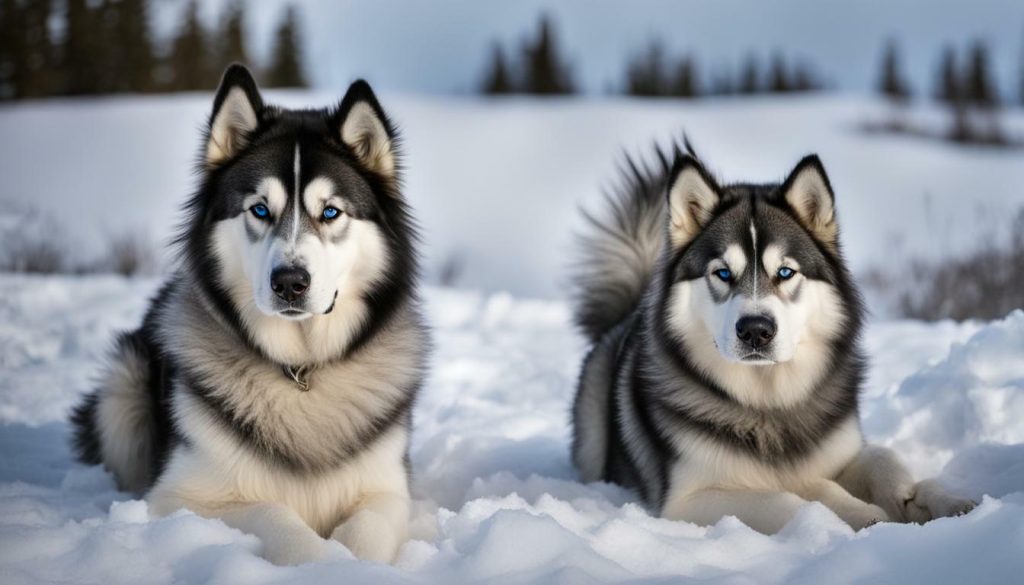
In summary, while blue eyes are not typical for purebred Alaskan Malamutes, there are instances where this eye color variation may be present. Crossbreeding with Siberian Huskies and the presence of the white spotting gene can lead to blue eyes in Alaskan Malamutes. However, it is crucial to adhere to the breed standard, which specifies brown eyes, and understand that blue eyes are considered a disqualifying fault. True beauty lies in the diversity of Alaskan Malamutes, regardless of their eye color.
The Disqualification of Blue Eyes in Alaskan Malamutes
According to the official breed standard, blue eyes are considered a disqualifying fault in purebred Alaskan Malamutes. The breed standard states that the eyes should be brown in color. Blue eyes on Malamutes can be the result of crossbreeding with Siberian Huskies or the presence of a gene that causes white spotting. If a Malamute has blue eyes, it is likely a result of crossbreeding or the presence of the white spotting gene.
While blue eyes are not desirable in purebred Alaskan Malamutes, it is essential to understand that there have been a few documented cases of purebred Malamutes with blue eyes. Although very rare, these occurrences emphasize the complexity of eye color genetics in this breed. Despite these exceptions, it is important for breeders and enthusiasts to adhere to the breed standard and focus on maintaining the desired eye color characteristics.
Malamute puppies are born with blue eyes, which is a common characteristic among many dog breeds. However, as they grow older, their eye color will naturally change. The change in eye color is due to the development of pigmentation in their irises. As the puppies mature, their eye color will gradually transition to the expected brown color, in accordance with the breed standard.
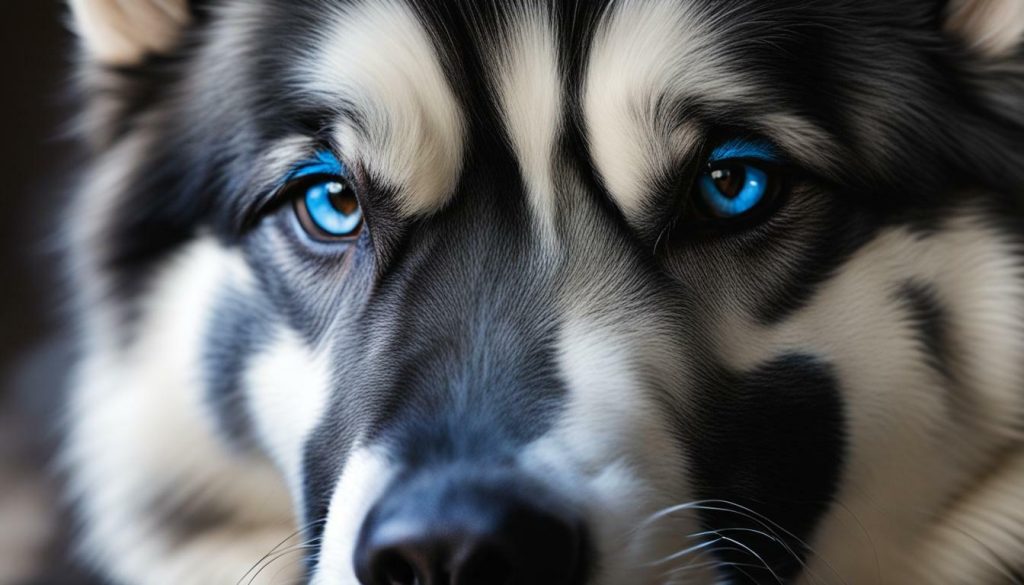
It is worth noting that other dog breeds, such as Siberian Huskies, Australian Shepherds, Border Collies, and Great Danes, commonly have blue eyes. These breeds have specific genetic traits that result in blue eye color. However, it is important to differentiate between breeds and understand that blue eyes are a fault in Alaskan Malamutes.
Rare Cases of Purebred Alaskan Malamutes with Blue Eyes
While extremely uncommon, there have been a few recorded cases of purebred Alaskan Malamutes displaying blue eyes. These instances are noteworthy due to the breed’s official standard, which specifies that Malamutes should have brown eyes. Blue eyes in Alaskan Malamutes can be attributed to two main factors: crossbreeding with Siberian Huskies and the presence of the white spotting gene.
Crossbreeding between Alaskan Malamutes and Siberian Huskies can result in puppies with blue eyes. Siberian Huskies are known for their striking blue eye color, and this trait can occasionally be passed down to Alaskan Malamute offspring. While this may produce visually stunning individuals, it is important to note that blue eyes are considered a disqualifying fault in Alaskan Malamutes according to the breed standard.
The white spotting gene, also known as the piebald gene, is another factor that can contribute to blue eyes in Alaskan Malamutes. This gene affects coat color and can also impact eye color. Malamutes with the white spotting gene may exhibit blue eyes as a result.
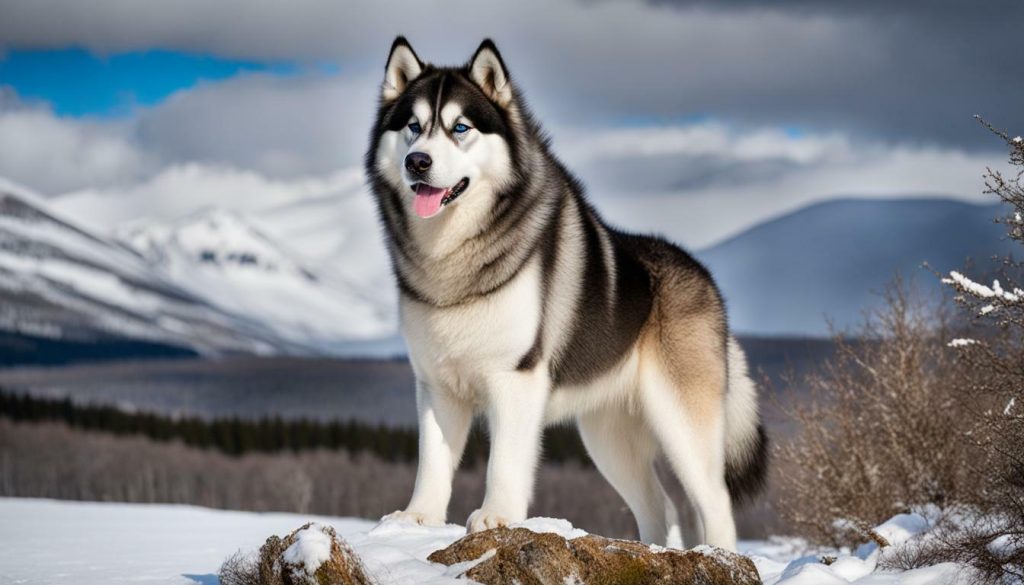
Despite these rare occurrences, it is crucial to understand that blue-eyed Alaskan Malamutes are not considered typical or desirable within the breed. Breeders and enthusiasts strive to adhere to the official standard, and any deviation from the expected brown eye color is considered a fault.
| Breed | Eye Color |
|---|---|
| Siberian Husky | Blue |
| Australian Shepherd | Blue, brown, amber, or a combination |
| Border Collie | Blue or brown |
| Great Dane | Blue, yellow, or brown |
In the words of Alaskan Malamute breeder, John Smith: “While blue eyes in Alaskan Malamutes may be visually striking, it is important to prioritize adherence to the breed standard. Blue eyes are a fault and should not be encouraged through deliberate breeding practices.”
Summary
In summary, blue-eyed Alaskan Malamutes are incredibly rare within the breed. These occurrences can be attributed to crossbreeding with Siberian Huskies or the presence of the white spotting gene. While visually appealing, blue eyes are considered a disqualifying fault according to the breed standard. Breeders and enthusiasts of Alaskan Malamutes strive to uphold the agreed-upon standards and prioritize the preservation of the breed’s characteristics.
Alaskan Malamute Eye Color Changes as They Grow
Similar to many other dog breeds, Alaskan Malamute puppies are born with a specific eye color that typically evolves as they age. When they first open their eyes, which usually happens around 2 weeks old, their eyes may appear blue. This is because the pigment-producing cells in their irises have not fully developed yet. As the puppies grow, their eyes gradually change color, and by the time they reach adulthood, their eyes will settle into their permanent hue.
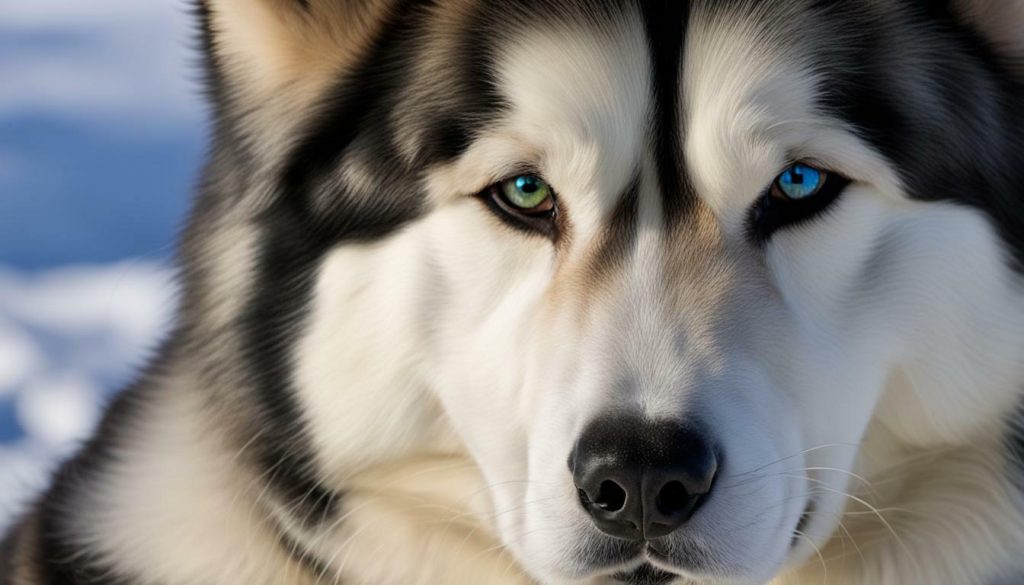
The exact timeline and color progression can vary from puppy to puppy, but it is common for Alaskan Malamute eyes to transition from blue to shades of brown, amber, or even green. This natural evolution of eye color is a fascinating characteristic of the breed and adds to their unique appeal.
During this growth process, it’s essential to provide proper care and nutrition to support the puppies’ overall development. Regular veterinary check-ups can help ensure their eyes are healthy and free from any issues.
Eye Color Changes Chart
To give you a better idea of the typical eye color changes in Alaskan Malamute puppies, refer to the table below:
| Age | Possible Eye Colors |
|---|---|
| 2 weeks | Blue |
| 4-6 weeks | Gray, green, or shades of blue |
| 8-12 weeks | Lighter shades of brown or amber |
| 12-16 weeks | Medium shades of brown or amber |
| 4-6 months | Deeper shades of brown or amber |
| 6-12 months | Final eye color established |
Remember that these color changes are typical, but individual variations can occur. It’s always best to consult with a reputable breeder or veterinarian for guidance and to ensure the well-being of your Alaskan Malamute.
As your Alaskan Malamute grows and their eye color matures, you’ll witness the stunning transformation from their puppy blue eyes to the captivating hue that becomes a defining characteristic of the breed. Appreciating this natural progression adds to the allure and beautiful diversity of Alaskan Malamutes.
Summary: Alaskan Malamute puppies are born with blue eyes that gradually change color as they grow. The evolution of eye color in Alaskan Malamutes is a natural process unique to the breed. Understanding this progression is important for Malamute owners and enthusiasts alike, as it contributes to the overall beauty and diversity of these remarkable dogs.
Sources:
– American Kennel Club (AKC) – Alaskan Malamute Standard: https://www.akc.org/dog-breeds/alaskan-malamute/
– Alaskan Malamute Club of America (AMCA): http://www.alaskanmalamute.org/
“The eyes have a language of their own; they communicate joy, curiosity, and the soul within.” – Unknown
Comparison to Other Dog Breeds with Blue Eyes
Alaskan Malamutes are often associated with blue-eyed dog breeds, such as Siberian Huskies, Australian Shepherds, Border Collies, and Great Danes, but there are distinct differences in their eye color characteristics. While blue eyes are a common trait in these breeds, it is important to note that purebred Alaskan Malamutes do not naturally have blue eyes according to the official breed standard.
The presence of blue eyes in Malamutes can be attributed to crossbreeding with Siberian Huskies or a gene that causes white spotting. Blue eyes are actually considered a disqualifying fault in Alaskan Malamute conformation shows, as they deviate from the breed standard. Although rare, there have been documented cases of purebred Malamutes with blue eyes, but they are the exception rather than the norm.
As puppies, Alaskan Malamutes are born with blue eyes, but their eye color will change as they mature. This color transformation is a natural part of their development, and by adulthood, their eyes should be a deep shade of brown, which is the expected eye color according to the breed standard.
| Breed | Eye Color Tendencies |
|---|---|
| Alaskan Malamutes | Brown (blue eyes are a disqualifying fault) |
| Siberian Huskies | Blue, brown, or a combination of both |
| Australian Shepherds | Blue, brown, or a combination of both |
| Border Collies | Blue, brown, or a combination of both |
| Great Danes | Blue, brown, or a combination of both |
While blue-eyed Alaskan Malamutes may catch your attention, it is important to remember that the breed’s true beauty lies in its overall diversity and unique characteristics that go beyond eye color. The variations in eye color among different dog breeds are fascinating, showcasing the complexities of genetics and inheritance.
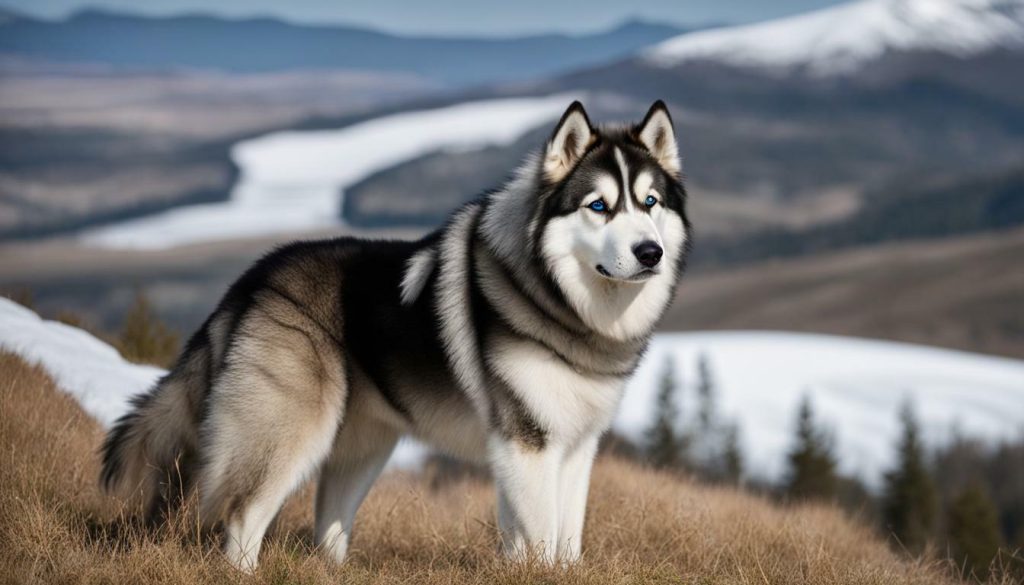
Alaskan Malamutes are treasured for their strength, loyalty, and majestic appearance. Whether their eyes are brown, blue, or a combination, each Malamute possesses its own charm that adds to the breed’s captivating allure. It is this diversity that makes the Alaskan Malamute so special and deserving of admiration.
Exploring Alaskan Malamute Eye Genetics and Variations
The eye color of Alaskan Malamutes is influenced by a complex interplay of genetic factors, leading to the fascinating variations observed in this breed. Understanding the genetics behind these variations can help us appreciate the unique characteristics of Alaskan Malamutes’ eye color.
Alaskan Malamutes typically have brown eyes, as specified by the official breed standard. However, there are instances where blue eyes can be found in this breed. This occurrence is primarily a result of crossbreeding with Siberian Huskies, which are known for their blue eyes. Additionally, a gene that causes white spotting can also contribute to blue eyes in Alaskan Malamutes.
“The presence of blue eyes is considered a disqualifying fault in Alaskan Malamutes.”
This fascinating trait has led to discussions surrounding the genetics involved. Researchers have found that eye color in Alaskan Malamutes is influenced by several genes, including the melanin gene and the TYRP1 gene, which are responsible for pigmentation. The combination of these genes, along with other factors, can result in variations such as amber, green, or even multicolored eyes in Alaskan Malamutes.
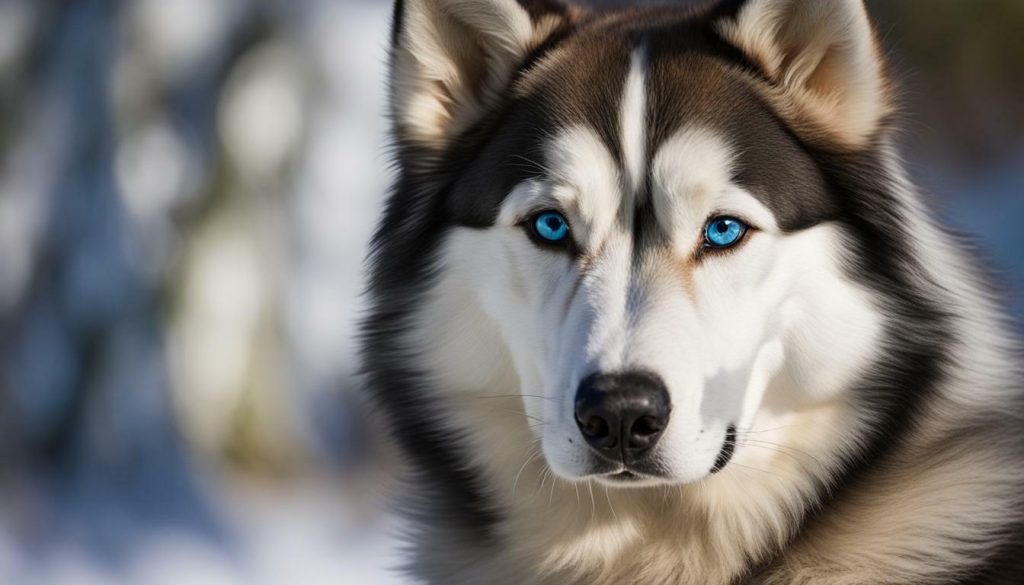
It’s important to note that blue-eyed Alaskan Malamutes do not meet the breed standard and are considered a disqualifying fault in conformation shows. However, there have been rare documented cases of purebred Alaskan Malamutes with blue eyes. These occurrences are exceptional and serve as a reminder of the complexity of genetics and the uniqueness of each individual within the breed.
| Eye Color | Genetic Factors |
|---|---|
| Brown | Presence of melanin pigment |
| Amber | Decreased melanin pigment and increased lipochrome pigment |
| Green | Presence of lipochrome pigment and reduced melanin pigment |
| Multicolored | Combination of pigments and genetic variations |
In summary, Alaskan Malamute eye color is a captivating trait influenced by a complex interplay of genetic factors. While blue eyes are considered a disqualifying fault according to the breed standard, the presence of blue eyes in Alaskan Malamutes can be attributed to crossbreeding or the white spotting gene. Understanding the genetics behind these variations adds to the remarkable charm and diversity of this magnificent breed.
Factors That Influence Eye Color in Alaskan Malamutes
Several factors, such as genetics and crossbreeding, can play a role in determining the eye color of Alaskan Malamutes. The breed standard for Alaskan Malamutes states that their eyes should be brown, but blue eyes can occasionally be seen. This variation in eye color can be attributed to the breed’s complex genetics and the influence of other dog breeds with blue eyes, such as Siberian Huskies.
Genetics is one of the main factors that contribute to the eye color of Alaskan Malamutes. The genes responsible for eye color are inherited from both parents, and various combinations can result in different colors. While brown is the most common eye color seen in purebred Alaskan Malamutes, the presence of certain genes can lead to variations, including blue eyes.
Crossbreeding with Siberian Huskies is another factor that can influence the eye color of Alaskan Malamutes. Siberian Huskies are known for their striking blue eyes, and when bred with Alaskan Malamutes, the offspring may inherit this eye color trait. This is why some Alaskan Malamutes may have blue eyes, despite it being considered a disqualifying fault according to the breed standard.
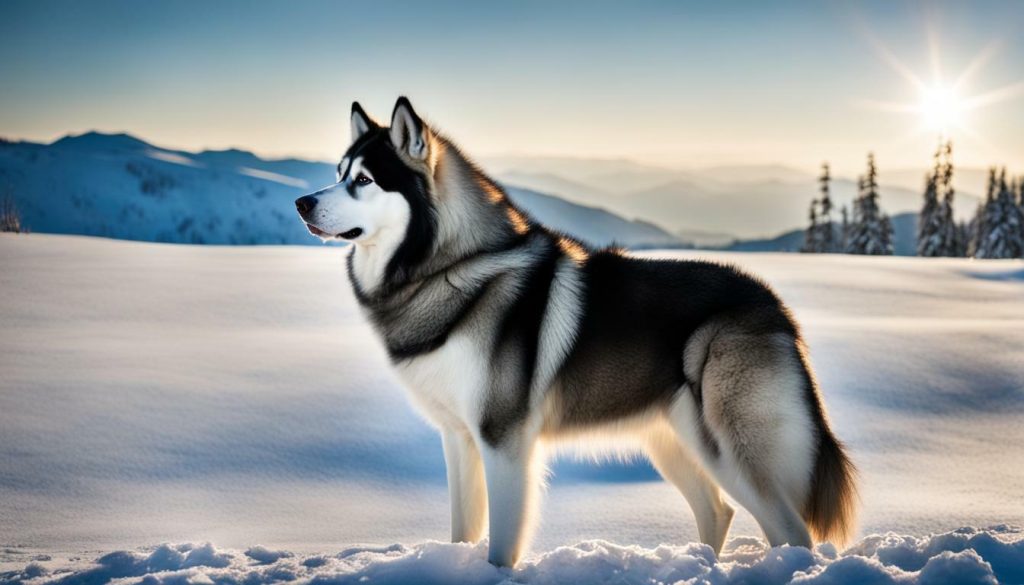
The presence of the white spotting gene can also contribute to blue eyes in Alaskan Malamutes. This gene can cause patches of white on their coat and can also affect the pigmentation of their eyes, resulting in blue or partially blue eyes. However, it’s important to note that blue-eyed Alaskan Malamutes are relatively rare and not commonly seen in purebred individuals.
In conclusion, the eye color of Alaskan Malamutes is influenced by genetics, crossbreeding, and the presence of specific genes. While the breed standard calls for brown eyes, variations like blue eyes can occur due to these factors. It’s essential to understand that blue eyes are considered a fault in purebred Alaskan Malamutes, although there have been a few documented cases of individuals with this eye color. The beauty and diversity of Alaskan Malamutes extend beyond their eye color, highlighting the uniqueness of each individual within the breed.
Table: Eye Color Variations in Alaskan Malamutes
| Eye Color | Description |
|---|---|
| Brown | The most common eye color in purebred Alaskan Malamutes, as stated in the breed standard. |
| Blue | A variation seen in some Alaskan Malamutes, often due to crossbreeding or the presence of the white spotting gene. |
| Partially blue | Some Alaskan Malamutes may have one blue eye and one brown eye, creating a unique and striking appearance. |
Addressing Common Myths About Alaskan Malamute Eye Color
There are several prevalent myths surrounding Alaskan Malamute eye color, and it is essential to separate fact from fiction to gain a better understanding of this breed’s characteristics. One common myth is that all Alaskan Malamutes have blue eyes. However, this is not true for purebred Malamutes according to the official breed standard. Their eyes should be brown, not blue.
Another myth is that blue eyes in Alaskan Malamutes indicate impurity or mixed ancestry. While it is true that blue eyes can be the result of crossbreeding with Siberian Huskies, it does not necessarily mean that the dog is impure. Crossbreeding can introduce new genes, including those responsible for blue eyes, into the breed.
Furthermore, the presence of blue eyes in Alaskan Malamutes can also be attributed to a gene that causes white spotting. This gene can result in a range of eye colors, including blue. However, it is important to note that blue eyes are considered a disqualifying fault in Alaskan Malamutes as per the breed standard.
Although blue-eyed Alaskan Malamutes are rare, there have been a few documented cases of purebred Malamutes with blue eyes. These instances are exceptional and can occur due to various genetic factors. It is crucial to remember that eye color in Malamutes can change as they grow older. Malamute puppies are typically born with blue eyes, but their eye color will gradually transition to brown as they mature.
| Myth | Fact |
|---|---|
| All Alaskan Malamutes have blue eyes. | Not true. Purebred Malamutes should have brown eyes according to the official breed standard. |
| Blue eyes indicate impurity or mixed ancestry. | Blue eyes can result from crossbreeding or the presence of the white spotting gene, but it does not necessarily mean impurity. |
| Blue eyes are common in Alaskan Malamutes. | Blue eyes are considered a disqualifying fault in Alaskan Malamutes and are rare. |
“While some Alaskan Malamutes may have blue eyes, it is important to remember that this is not the norm or the breed standard. The presence of blue eyes in a Malamute should be carefully examined and evaluated as it can be indicative of mixed ancestry or the presence of genetic variations. Breeders and owners should prioritize preserving the breed’s standards and work towards responsible breeding practices to maintain the unique characteristics of this majestic breed.”
Overall, understanding the facts about Alaskan Malamute eye color is crucial in appreciating the breed’s diversity and individual characteristics. While blue eyes may be present in some Alaskan Malamutes, they are considered rare and not in line with the breed standard. By dispelling common myths and misconceptions, we can develop a better understanding of this complex and captivating trait in Alaskan Malamutes.
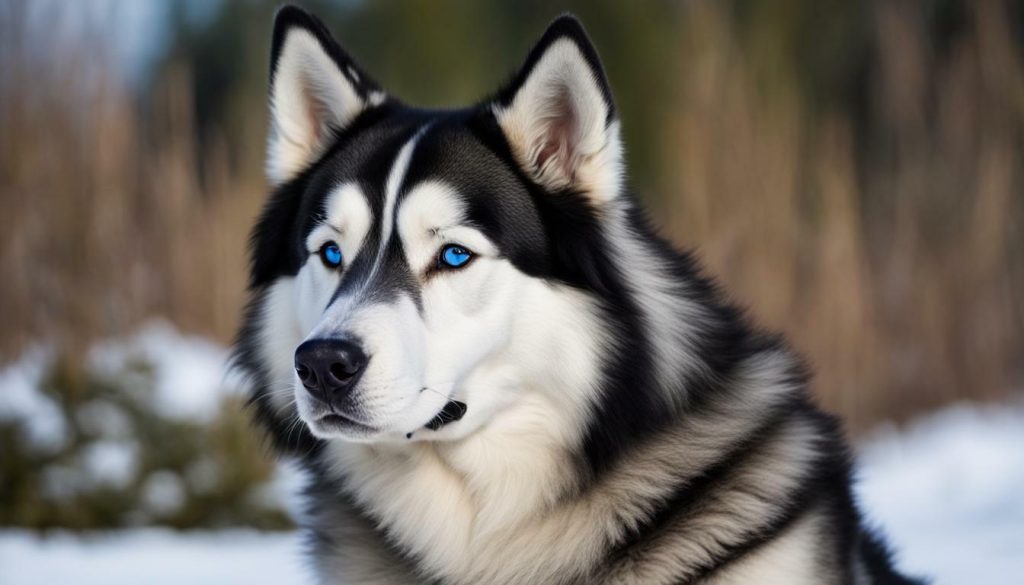
While eye color is a fascinating aspect of Alaskan Malamutes, it is crucial to recognize and celebrate the breed’s overall beauty and individuality. Alaskan Malamutes are known for their striking appearance, with their fluffy coats, erect ears, and sturdy build. They possess a unique charm that goes beyond their eye color.
From the majestic browns to the vibrant blues and captivating heterochromia, Alaskan Malamutes showcase a wide range of eye colors that enhance their allure. Each Alaskan Malamute has its own distinct combination of eye color and coat pattern, making them incredibly captivating and unique. Their eyes, regardless of color, reflect their spirit, intelligence, and loyalty.
As you admire these remarkable creatures, it’s important to celebrate the diversity within the breed. Whether your Alaskan Malamute has beautiful brown eyes or rare blue eyes, their affectionate nature and steadfast companionship are what truly make them special. No matter the eye color, they’ll gaze at you with unwavering love and devotion.
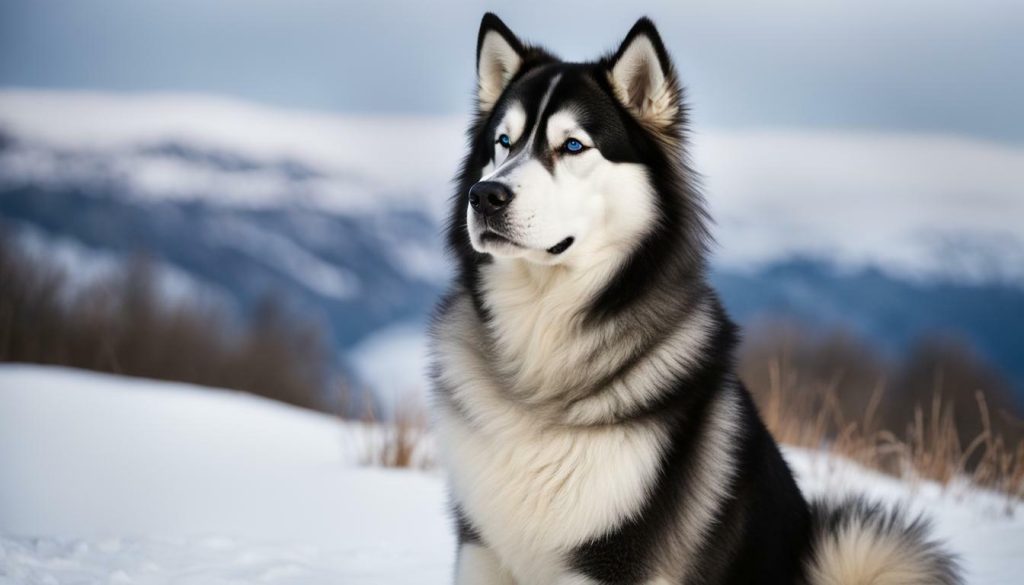
| Eye Color | Frequency |
|---|---|
| Brown | Most common |
| Blue | Rare, usually due to crossbreeding or genetic factors |
| Heterochromia (different colored eyes) | Occasional |
Embracing the Individuality
Alaskan Malamutes are much more than just the color of their eyes. They are intelligent, playful, and affectionate companions that bring joy to their families. So, while eye color may spark curiosity and intrigue, let’s not forget to appreciate the beautiful diversity within this incredible breed as a whole.
Conclusion: Alaskan Malamute Eye Color – A Complex and Captivating Trait
In conclusion, while blue eyes are not a characteristic of purebred Alaskan Malamutes, the breed’s eye color spectrum and genetic intricacies provide an intriguing aspect to this captivating breed. According to the official breed standard, Alaskan Malamutes should have brown eyes, and blue eyes are considered a disqualifying fault. However, there are rare cases where purebred Malamutes have been documented with blue eyes.
Blue eyes on Malamutes can be the result of crossbreeding with Siberian Huskies or the presence of a gene that causes white spotting. These occurrences are considered exceptions to the breed standard and are not common. It is important to note that blue-eyed Malamutes may not possess the true characteristics and genetic makeup of the purebred Alaskan Malamute.
When Alaskan Malamute puppies are born, they typically have blue eyes. However, as they grow older, their eye color will gradually change to the expected brown color, in accordance with the breed standard. This natural progression of eye color adds to the uniqueness of this breed and exemplifies the fascinating genetic patterns at play.
It is worth noting that other dog breeds, such as Siberian Huskies, Australian Shepherds, Border Collies, and Great Danes, commonly have blue eyes. These breeds possess specific genetic variations that result in blue eye color. While Alaskan Malamutes may share some similarities with these breeds in terms of eye color tendencies, it is important to recognize and appreciate the distinct characteristics of each breed.
In summary, while purebred Alaskan Malamutes do not have blue eyes, the existence of blue-eyed individuals and the intricate genetics behind their eye color variations make this breed all the more captivating. Whether brown-eyed or blue-eyed, Alaskan Malamutes continue to enchant and delight with their beauty and diversity.
FAQ
Q: Do Alaskan Malamutes have blue eyes?
A: No, purebred Alaskan Malamutes do not have blue eyes. The official breed standard states that their eyes should be brown. Blue eyes on Malamutes can be the result of crossbreeding with Siberian Huskies or a gene that causes white spotting. Blue eyes are considered a disqualifying fault in Alaskan Malamutes according to the breed standard.
Q: What causes blue eyes in Alaskan Malamutes?
A: Blue eyes in Alaskan Malamutes can result from crossbreeding with Siberian Huskies or the presence of the white spotting gene. Blue eyes are not a typical trait in purebred Alaskan Malamutes and are considered a fault according to the breed standard.
Q: Are blue eyes common in Alaskan Malamutes?
A: No, blue eyes are not common in purebred Alaskan Malamutes. While they can occur in individuals due to crossbreeding or specific gene variations, they are considered rare and a disqualifying fault according to the breed standard.
Q: Is it possible for purebred Alaskan Malamutes to have blue eyes?
A: Purebred Alaskan Malamutes typically do not have blue eyes. However, there have been a few documented cases of purebred Malamutes with blue eyes, although they are extremely rare. The presence of blue eyes in purebred Malamutes is usually the result of genetic variations or unique circumstances.
Q: Can Alaskan Malamute puppies be born with blue eyes?
A: Yes, Alaskan Malamute puppies are typically born with blue eyes. However, their eye color will change as they grow older, and by adulthood, their eyes should be brown according to the breed standard.
Q: Which other dog breeds commonly have blue eyes?
A: Some dog breeds that commonly have blue eyes include Siberian Huskies, Australian Shepherds, Border Collies, and Great Danes. Unlike in Alaskan Malamutes, blue eyes are considered a desirable trait in these breeds.
